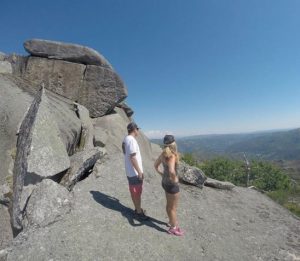The National Park of Peneda-Gerês extends from the plateau of Castro Laboreiro to the plateau of Mourela. In its area it includes territories of the counties of Melgaço, Arcos de Valdevez, Bridge of the Barca, Terras de Bouro and Montalegre.
The Park includes an area of 702.90 km2, of which 52.75 km2 are public lands, 194.38 km2 are private property and the remaining 455.77 km2 are commons.
The creation of the national park (completed under decree no. 187/71, 8 May 1971) envisioned a planning area of mountainous spaces, in order to conserve the environment, while permitting human and natural resource activities, which would include educational, touristic and scientific projects. At heart is the conservation of soils, water, flora and fauna, in addition to the preservation of landscapes within the vast mountainous region in the northwest of Portugal.
The Peneda-Gerês National Park, also known simply as Gerês, is the only national park in Portugal (although many natural parks, protected landscapes, and reserves exist across the nation).
The exuberant vegetation covering the mountains, exhibit every shade of green, include a holly bush wood – unique at a national level – and endemic species such as the Gerês lily, whose blue-violet colours grace the fields. The rugged mountainous terrain is cut across by rapidly flowing rivers and streams, including many waterfalls, which finally slow down their pace in dams such as those of Caniçada, Vilarinho das Furnas or Portela do Homem. The landscapes are quite stunning.

In some places it is possible to observe magnificent landscapes that encompass natural and human aspects, such as the Miradouro da Pedra Bela (360° panoramic view). If you want to expend some energy there are plenty of opportunities, since you’ll find ideal conditions for several activities such as canyoning or waterfall trek.
TOURS AVAILABLE FOR THIS LOCATION
Extreme canyoning
About the extreme canyoning tour, many say that this is the most immersive nature activity you can make. Feel connected with the surroundings and venture out into a world of sensations. A day filled with great rappelling moments, sky-high jumps and amazing views and spots that can only be reached with the proper guides and material. Book now!
Gerês Waterfall Trek
In the Waterfall Trek Tour Along your day you will be able to visit several landmarks of the park, including the famous Tahiti Waterfalls (Fecha de Barjas) where you can enjoy a refreshing swim and the Pedra Bela Viewpoint which has an incredible view over the whole landscape. Book now!
If you have not yet had the opportunity to visit the Peneda-Gerês National Park, it’s time to plan a Detour. You will be fascinated by the landscapes, waterfalls, forests and all the other treasures that can be found in Portugal’s only national park. Our guides have local knowledge and will take you through a trip deep inside this natural paradise with all the safety and plenty of fun.
Discover this vast amphitheatre sculptured by geological formations, winds and water. Book now!











